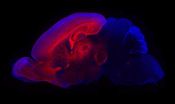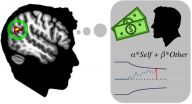(Press-News.org) JUPITER, FL, July 15, 2015 - As early as 1943, when autism was first described by psychiatrist Leo Kanner, reports were made that some, but not all, children with autism spectrum disorder have relatively enlarged heads. But even today, more than half a century later, the exact cause of this early abnormal growth of the head and brain has remained unclear.
Now, scientists from the Florida campus of The Scripps Research Institute (TSRI) have uncovered how mutations in a specific autism risk gene alter the basic trajectory of early brain development in animal models.
The study, published in the July 15 issue of The Journal of Neuroscience, focused on the gene PTEN (Phosphatase and tensin homolog), which is mutated in around 20 percent of individuals with autism spectrum disorder and enlarged heads (macrocephaly).
In new research, the team led by Scripps Florida biologist Damon Page found that mutations in PTEN, which approximate those found in a subgroup of individuals with autism spectrum disorder, lead to dynamic changes in the number of two key cell types that make up the brain--neurons and glia. At birth, neurons are more abundant than normal. Surprisingly, in adulthood the number of neurons in the brains of mutant animals is virtually the same as normal, and glia (which provide support for neurons) are overrepresented.
"In the adult brain, excess glia are a primary cause of the overall change in brain size," Page said. "This raises the intriguing possibility that these excess glia may, in fact, contribute to abnormal development and function of brain circuitry when PTEN is mutated."
The brain overgrowth the team observed in PTEN mutant mice is a dynamic process, with the greatest increase in size occurring at birth and adulthood and the least in the early juvenile period. The team noted that this abnormal pattern of growth appears to be caused by an amplification of the normal process of brain development, where neurons are generated in over-abundance before birth and then trimmed off by a program of cell death (apoptosis), and glia are generated after neurons.
"Apoptosis is a natural phenomenon that removes unnecessary neurons during normal brain development," said Research Associate Youjun Chen, the first author of the study and a member of the Page laboratory. "We find it very striking that in the brains of PTEN mutant mice, the presence of excess neurons is corrected by excessive apoptosis. After that, excess glia are made. In adulthood, the number of glial cells increases by more than 20 percent in our models."
The scientists traced these effects back to an increase in signaling through a molecule known as β-Catenin (beta Catenin).
"PTEN and β-catenin are two important molecules that control growth in the developing brain in both mice and humans," said Page. "We have found that these work together in a common pathway to regulate brain growth trajectory by controlling the number and types of cells produced. Although caveats apply when extrapolating from mice to humans, this suggests that an imbalance in this relationship may contribute to abnormal brain growth in a subset of individuals with autism spectrum disorder."
Autism spectrum disorder is a neurodevelopmental disorder characterized by social deficits and communication difficulties, repetitive behaviors and interests, as well as cognitive delays in some individuals. The disorder affects in approximately one percent of the population; some 80 percent of those diagnosed are male.
Interestingly, Page noted that in spite of the profound effects of PTEN mutations on brain growth, the mice are largely able to adapt at the level of behavior, with the important exception of social behavior and a few other behaviors relevant to autism spectrum disorder.
"Our findings across studies indicate that it may be a multiple-hit process," he said. "While abnormal growth puts stress on the developing brain, the brain works hard to compensate for that. How well an individual can adapt to an abnormal pattern of brain growth may shape their outcome in terms of behavior and cognition. The capacity to adapt may, in turn, be influenced by genetic or environmental factors."
In addition to Page and Chen, other authors of the study, "Pten Mutations Alter Brain Growth Trajectory and Allocation of Cell Types through Elevated β-Catenin Signaling," are Wen-Chin Huang, Julien Sejourne and Amy E. Clipperton-Allen of TSRI.
INFORMATION:
This work was supported by the state of Florida, Ms. Nancy Lurie Marks, the Simons Foundation (grant award 360712), an O'Keeffe Neuroscience Scholars Award and the Fraternal Order of Eagles.
Montreal, July 15, 2015 - A Canadian research team at the IRCM in Montreal, led by molecular virologist Eric A. Cohen, PhD, made a significant discovery on how HIV escapes the body's antiviral responses. The team uncovered how an HIV viral protein known as Vpu tricks the immune system by using its own regulatory process to evade the host's first line of defence. This breakthrough was published yesterday in the scientific journal PLOS Pathogens and will be presented at the upcoming IAS 2015 conference in Vancouver. The findings pave the way for future HIV prevention or cure ...
BOSTON - New research led by investigators at Beth Israel Deaconess Medical Center (BIDMC) provides the first direct evidence linking traumatic brain injury to Alzheimer's disease and chronic traumatic encephalopathy (CTE) -- and offers the potential for early intervention to prevent the development of these debilitating neurodegenerative diseases. TBI can result from repetitive contact sport injuries or from exposure to military blasts, and is one of the most significant risk factors for both Alzheimer's disease and CTE.
In a study published today in the online edition ...
Scientists at the University of Basel were able to identify for the first time a molecule responsible for the absorption of starlight in space: the positively charged Buckminsterfullerene, or so-called football molecule. Their results have been published in the current issue of Nature.
Almost 100 years ago, astronomers discovered that the spectrum of star light arrived on earth with dark gaps, so-called interstellar bands. Ever since, researchers have been trying to find out which type of matter in space absorbs the light and is responsible for these "diffuse interstellar ...
About 1 in 88 children has an autism spectrum disorder. This represents a 78% increase in the incidence of autism spectrum disorder since 2002 (although some of the increase may be due to improved diagnostic capabilities). Individuals with an autism spectrum disorder may have poor nutrition because they often exhibit selective eating patterns as well as sensory sensitivity that predispose them to restrict their diets.
The July 2015 issue of Advances in Nutrition, the international review journal of the American Society for Nutrition, features "Nutritional Status of ...
GeoSpace
Greenland's fjords are far deeper than previously thought, and glaciers will melt faster, researchers find
West Greenland's fjords are vastly deeper than rudimentary models have shown and intruding ocean water can badly undercut glacier faces. A new study in Geophysical Research Letters explores how this process will raise sea levels faster than expected.
Eos.org
A University-Government Partnership for Oceanographic Research
After 44 years of coordinating the U.S. academic research fleet and facilities, the University-National Oceanographic Laboratory System ...
CORVALLIS, Ore. - Air pollution controls installed at an Oregon coal-fired power plant to curb mercury emissions are unexpectedly reducing another class of harmful emissions as well, an Oregon State University study has found.
Portland General Electric added emission control systems at its generating plant in Boardman, Oregon, in 2011 to capture and remove mercury from the exhaust.
Before-and-after measurements by a team of OSU scientists found that concentrations of two major groups of air pollutants went down by 40 and 72 percent, respectively, after the plant was ...
A new computational model of how the brain makes altruistic choices is able to predict when a person will act generously in a scenario involving the sacrifice of money. The work, led by California Institute of Technology scientists and, appearing July 15 in the journal Neuron, also helps explain why being generous sometimes feels so difficult.
The reason people act altruistically is well contested among academics. Some argue that people are innately selfish and the only way to override our greedy tendencies is to exercise self-control. Others are more positive, believing ...
WASHINGTON, DC - July 15, 2015 - For decades, researchers have worked to improve cacao fermentation by controlling the microbes involved. Now, to their surprise, a team of Belgian researchers has discovered that the same species of yeast used in production of beer, bread, and wine works particularly well in chocolate fermentation. The research was published ahead of print July 6th in Applied and Environmental Microbiology, a publication of the American Society for Microbiology.
"Chemical analyses as well as tasting the chocolate showed that the chocolate produced with ...
LAWRENCE -- American media in effort to highlight a diverse set of voices in covering politics generally over-represent the amount of people who contribute to policy making when compared with journalists in South Korea.
A University of Kansas researcher made the findings as part of a recent study that examined how government officials were treated in front-page news coverage between the two free-press nations. The article by Jiso Yoon, a KU assistant professor of political science, and co-author Amber Boydstum, an assistant professor of political science at the University ...
AURORA, Colo. (July 15, 2015) - Physicians at the University of Colorado School of Medicine on the Anschutz Medical Campus have published research that suggests a safe and lower-cost way to diagnose and treat problems in the upper gastrointestinal tract of children.
The researchers assessed the effectiveness of unsedated transnasal endoscopy (TNE) in evaluating pediatric patients with potentially chronic problems in their esophagus, which is the tube that connects the patient's mouth to the stomach. The research team included Joel A. Friedlander, DO, MA-Bioethics, Jeremy ...


